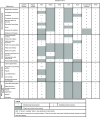Measuring the aggregated impact of research: Establishing criteria for coding Translational Science Benefits Model data
- PMID: 40599181
- PMCID: PMC12209970
- DOI: 10.1017/cts.2025.76
Measuring the aggregated impact of research: Establishing criteria for coding Translational Science Benefits Model data
Abstract
Introduction: A promising approach to assessing research impact draws on the Translational Science Benefits Model (TSBM), an evaluation model that tracks the applied benefits of research in four domains: Clinical and Medical; Community and Public Health; Economic; and Policy and Legislative. However, standardized methods to verify TSBM benefit data, to aid in aggregating impact data within quantitative summaries, do not currently exist.
Methods: A panel of 11 topic experts participated in a modified Delphi process for establishing content and face validity of a set of criteria for verifying qualitative TSBM data. Two survey rounds were completed by panelists, with a moderated discussion in between rounds to discuss criteria not reaching consensus. Criteria with panel consensus at or above 70% in the survey rounds were confirmed as validated.
Results: Criteria fell into 9 categories: Content Relevant, Project Related, Who, Reach, What, How, Novel, Documented Evidence, and When. The Delphi process yielded 197 total criteria across the 30 benefits characterized by the TSBM (range = 5-8 criteria per benefit).
Discussion: The results of this Delphi process lay the foundation for developing a TSBM coding tool for evaluating and quantifying TSBM data. Standardizing this process will enable data aggregation, group analysis, and the comparison of research impact across contexts.
Keywords: Delphi panel; Research impact evaluation; coding criteria; content validation; health research; societal impact.
© The Author(s) 2025.
Conflict of interest statement
The author(s) declare none.
Figures
Similar articles
-
Home treatment for mental health problems: a systematic review.Health Technol Assess. 2001;5(15):1-139. doi: 10.3310/hta5150. Health Technol Assess. 2001. PMID: 11532236
-
Health professionals' experience of teamwork education in acute hospital settings: a systematic review of qualitative literature.JBI Database System Rev Implement Rep. 2016 Apr;14(4):96-137. doi: 10.11124/JBISRIR-2016-1843. JBI Database System Rev Implement Rep. 2016. PMID: 27532314
-
Intravenous magnesium sulphate and sotalol for prevention of atrial fibrillation after coronary artery bypass surgery: a systematic review and economic evaluation.Health Technol Assess. 2008 Jun;12(28):iii-iv, ix-95. doi: 10.3310/hta12280. Health Technol Assess. 2008. PMID: 18547499
-
Leveraging the translational science benefits model to enhance planning and evaluation of impact in CTSA hub-supported research.Front Public Health. 2025 Jun 5;13:1593920. doi: 10.3389/fpubh.2025.1593920. eCollection 2025. Front Public Health. 2025. PMID: 40538693 Free PMC article.
-
The Translational Science Benefits Model, a new training tool for demonstrating implementation science impact: A pilot study.J Clin Transl Sci. 2024 Oct 2;8(1):e142. doi: 10.1017/cts.2024.573. eCollection 2024. J Clin Transl Sci. 2024. PMID: 39478778 Free PMC article.
References
-
- Molas J, Tang P, Morrow S. Assessing the non-academic impact of grant-funded socio-economic research: Results from a pilot study. Res Evaluat. 2000:9:171–182. doi: 10.3152/147154400781777269. - DOI
-
- Reed MS, Ferré M, Martin-Ortega J, et al. Evaluating impact from research: a methodological framework. Res Policy. 2021;50(4):104147. doi: 10.1016/j.respol.2020.104147. - DOI
-
- Bornmann L. Measuring impact in research evaluations: A thorough discussion of methods for, effects of and problems with impact measurements. High Educ. 2017;73(5):775–787. doi: 10.1007/s10734-016-9995-x. - DOI
Associated data
LinkOut - more resources
Full Text Sources


